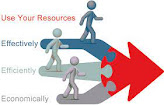The Carnegie Mellon University Software Development Institute has developed the Human Capability Development Model (P-CMM) to help companies manage knowledge workers across global boundaries and between old and younger generations. Similar to CMMI, P-CMM has five levels of maturity, but the model focuses on the need to improve the abilities of the workforce as a discriminating factor in competition.
Perhaps you think these questions are unreasonable, and perhaps they are. But we live in an unreasonable world where all the benefits must be realized. Because until you're able to easily answer these questions, the vast majority of your competitors can. Guess who has the advantage when it comes to completing complex, notable projects?
Fortunately, there are ways to quickly gain this knowledge. There are now several excellent programs that can provide all the information you need to answer the above questions on one dashboard. What's more, you can implement a system in your company that allows you to benefit from well-tracked projects and resources.
1. Know where your people are and where they should be.
In any organization, the immediate benefits of knowing what your employees are doing at any given moment should be quite obvious, because you want them to work on tasks that are useful to the company. But if you mistakenly think that any progress is useful – the roles become static and monotonous. Companies in which the same employee does the same job for a long time weaken themselves and their employees. While roles are not dynamic, people are dynamic. Over time, workers can learn to perform individual tasks and succeed in areas outside of their usual roles.
If you do not show attention, you can lose productivity. In addition, your employees will quickly lose interest and become dissatisfied. Implementing a system that allows employees to track time for individual tasks will allow you to find out what they are most effective at. They probably try best at the tasks they love. There's no need to change employees' job roles every day, but consider a change when the facts show they've worked out skills in a new field.
2. Know exactly what kind of people and resources you have available
Project planning can be very lengthy and time-consuming, but it is essential to ensure the successful completion of the project. An important element is the creation of your group. This task is greatly simplified when you know exactly who is available (with the skill sets you need) and what their schedule will be over the course of the project.
For example, if you assign an employee to tasks and then find out that the employee has planned his annual two-week trip to Acapulco in the middle of the project, this will cause unnecessary stress. If you have an automated project management system in place, employee schedules are clear and any requests for leave will be noticed. You'll also know what tasks other workers are working on, so you can prevent resources from being overloaded with work or assigning a person to inappropriate tasks.
3. Track time for individual projects
It is useful to track the time spent by the employee on projects, but the maximum benefit comes from tracking each project separately. This allows you to view each project as a unique element in the company's profitability. This idea is very useful when allocating resources, as you will know the parameters of each project regarding the current workload of the company. While too many metrics can paralyze decision-making, heterogeneous metrics allow you to execute projects with surgical precision.
4. Analyze resource usage versus project execution
Perhaps this is the most useful time tracking feature for individual projects, as it prevents waste of time or money. If you compare the time and resources spent on a project with the percentage of completion, you can understand which projects consume too many resources and are therefore unprofitable. This allows you to reallocate resources to projects if necessary or liquidate unprofitable projects. It's always best to identify issues earlier, and dynamic tracking provides that capability. Sometimes it is better to stop an unprofitable business and move on; expenses can quickly get out of control, aggravating your situation.
5. Keep a log of all projects
In the long run, owning a project journal will be very valuable, although creating one is time-consuming. It allows you to make an assessment with high accuracy: to determine how many people are usually required to complete the project; Improve the accuracy of budgets based on scale and improve the timing based on the overall parameters of the project. Even the least effective projects become valuable because you can glean just as much information from them. You'll learn what didn't work, what factors caused the money to overspend, and you'll learn from mistakes. Keep a high-quality journal and ensure its availability, as it reduces the number of errors in the most important business tasks, and saves time and money.
None of these actions are difficult, and with a high-quality automated project time tracking system in place, they take less time than traditional paper time logs. Commercial benefits make an automated system worth the effort, and saving time and resources will bring tremendous benefit to your company. A deeper understanding of your processes will allow you to act quickly and efficiently, and stay ahead of any competitors in the implementation of important (and profitable) projects.








No comments:
Post a Comment